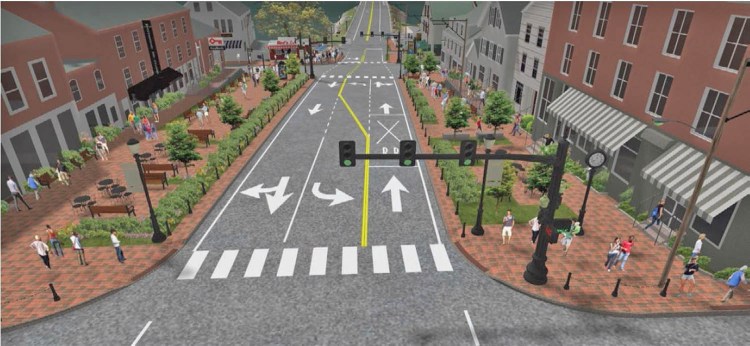WISCASSET — The Maine Department of Transportation plans to move forward with planned traffic improvements in downtown Wiscasset despite a 3 to 2 vote by the Wiscasset Select Board to withdraw its support for the project.
The board withdrew support on June 20, with members Ben Rines, Katharine Martin-Savage, and Bob Blagden voting to send a letter to the DOT saying it doesn’t support the project. That vote came in the wake of a referendum that passed 400-323 June 13 that asked whether voters would “disapprove and reject, by a binding referendum, the changes made by the Maine Department of Transportation to the Route 1/Main Street Option No. 2 Project approved by voters in June 2016.”
The vote is not binding, according to legal advice given to both Wiscasset and the state’s transportation department.
“We are puzzled to hear that three select board members have voted against the project,” said Ted Talbot, press secretary for DOT. Talbot said the vote was to reject changes to Option 2, which is the “very project that Maine DOT has been developing over the last year.”
So far, the department has spent $622,000 on the project. That cost includes the acquisition via eminent domain of the Haggett Garage property on Water Street.
The entire project is expected to cost about $5 million, to be paid with state funds.
It includes eliminating on-street parking, widening sidewalks along Main Street, installing benches and greenery in the extended sidewalks, installing new traffic lights and turn-out lanes at intersections, and creating a new parking lot at the site of Haggett’s Garage.
The referendum question was put on the ballot thanks to a petition by the Wiscasset Taxpayers Alliance, a group of residents who disagreed with how the DOT is pursuing the project. Bill Sutter, spokesman for the group, said DOT’s withdrawal of federal funding is a key sticking point.
“They chose not to use federal funds and chose not to apply the standards of historic preservation to the project,” he said. Federal funding would cause the project to undergo Section 106 historic preservation standards.
“Wiscasset is not opposed to helping in any way we can, reasonably, in moving of traffic,” Sutter said, adding other DOT proposals have less of an effect on downtown, but still improve traffic flow. “I don’t think there’s any opposition to doing what is reasonably possible to address the DOT’s goals of increasing traffic flow through Wiscasset.”
Talbot said the referendum was “tainted by misinformation and misleading statements,” and that the DOT is continuing to work with the town’s advisory committee on the project. “Maine DOT will continue to make every effort to work collaboratively with the town, but we are committed to moving the project forward.”
Neighboring towns are watching the process in Wiscasset with interest. Alna, Edgecomb and Newcastle are all just north of Wiscasset, and can be affected by traffic issues, especially in the summer.
“I’ve gone down to one of the public meetings and testified in support of (the project) on behalf of our town,” said Alna Select Board member Douglas Baston. He was reluctant to comment specifically on the issues in Wiscasset, as it’s not his jurisdiction and he prefers to remain out of other towns’ business. However, he does point out that the issue of traffic is regional.
“I see up and down (Route) 218 when the volume of traffic quadruples or sextuples, I know Wiscasset is jammed up,” he said.
He also added that he doesn’t envy the position Wiscasset or the DOT is in. “It’s a little frustrating, because Wiscasset has a problem that’s not of their own making. I think it’s unfortunate, and I think it puts DOT in a bit of a public relations problem.”
Newcastle Select Board member Benjamin Frey said he also sees an impact from traffic, and said he’d offer his services “in any way he could” to help Wiscasset figure things out. “Temperatures and emotions run high on this one. But if you look back at the history of this, every idea that has been put forth has been rejected.”
While Frey was reluctant to comment on any specifics of the process, he said in Newcastle they’ve used volunteers and traffic cones to try out different traffic patterns to see how they work.
“Maybe just do something no-cost, a couple of volunteers go out there and put up some traffic cones to test these kind of things,” he said. “We just tested doing different traffic patterns to see how it would work.”
The DOT shows no signs of slowing down on the project. A site walk was recently performed with the advisory committee, and Talbot said meetings with the committee are ongoing.
“Meetings with the town’s advisory committee have been informative and productive,” Talbot said. “We also know there is a lot of local and regional support for the project and an expectation from the traveling public that Maine DOT will improve the longstanding congestion and pedestrian safety concerns in Wiscasset.”
cchase@coastaljournal.com
Send questions/comments to the editors.



Comments are no longer available on this story